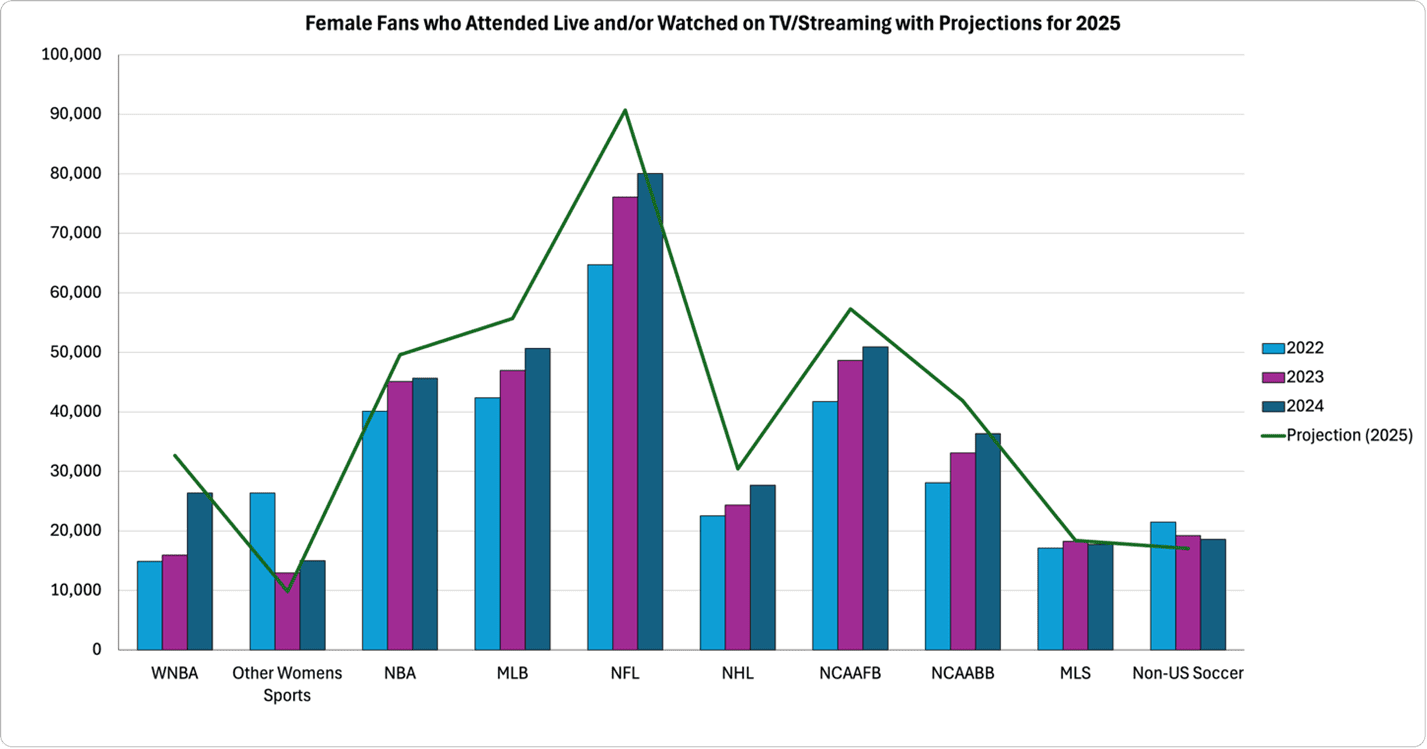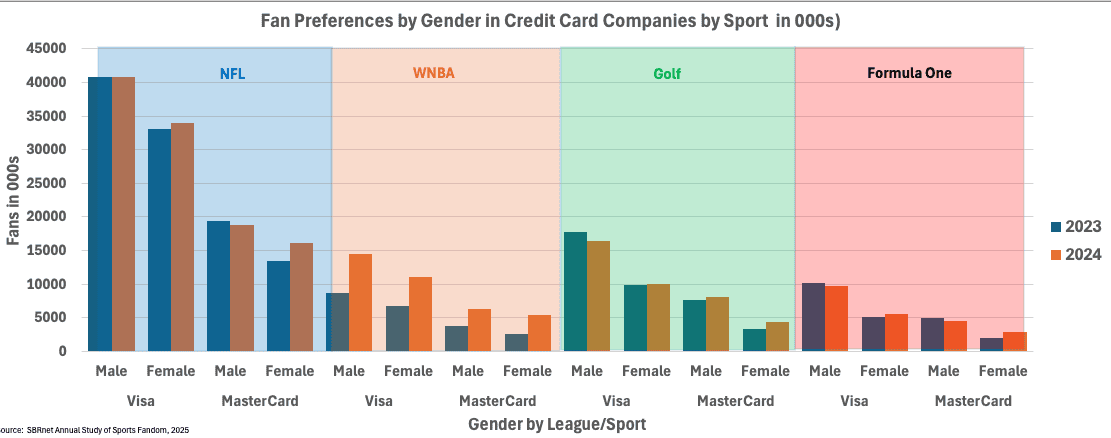Topic
- Consumer Behavior/Understanding
- Research
 Throughout 2025, much of sports news has been dominated by the growth of women’s sports, not only in the USA, but worldwide. Hardly a day goes by that there is not a story about WNBA players Caitlin Clark or Angel Reese. There is no question that we are seeing growth from the WNBA, as well as other women’s sports, mostly focused on professional soccer and, to a smaller degree, women’s professional ice hockey. According to data from the most recent study of sports fandom produced by SBRnet, women now account for nearly 50% of all sports fans. No longer an afterthought, marketers, brands, and sponsors alike need to adjust existing marketing plans and strategies to focus more on women with greater purpose. For a long time, marketers and brands used “pink it and shrink it” strategies hoping to reach female sports viewers. This is no longer the case; women sports fan have increased and brands must update strategies to better reach this growing market. The chart below shows the two-year growth trends for women’s sports fans across all the sports currently included in SBRnet’s yearly study of sports fandom.
Throughout 2025, much of sports news has been dominated by the growth of women’s sports, not only in the USA, but worldwide. Hardly a day goes by that there is not a story about WNBA players Caitlin Clark or Angel Reese. There is no question that we are seeing growth from the WNBA, as well as other women’s sports, mostly focused on professional soccer and, to a smaller degree, women’s professional ice hockey. According to data from the most recent study of sports fandom produced by SBRnet, women now account for nearly 50% of all sports fans. No longer an afterthought, marketers, brands, and sponsors alike need to adjust existing marketing plans and strategies to focus more on women with greater purpose. For a long time, marketers and brands used “pink it and shrink it” strategies hoping to reach female sports viewers. This is no longer the case; women sports fan have increased and brands must update strategies to better reach this growing market. The chart below shows the two-year growth trends for women’s sports fans across all the sports currently included in SBRnet’s yearly study of sports fandom.

Brand Partnership Strategy
The increasing influence of female fans presents a significant opportunity for sports teams and leagues. By shifting from broad, male-focused promotions to specific, data-driven marketing, teams can better connect with this key demographic. Partnering with brands that have already built strong connections with women is a powerful way to grow the female fanbase and elevate their gameday experience. For the product categories used here, we opted to focus on the NFL, WNBA, Golf, and Formula One.
Case 1: Sports Drinks
Sports drinks are one of the biggest sponsors for various sports leagues and teams and among the biggest spenders when it comes to reaching sports fans, so it’s important to partner with the right sports drink brands. By creating a more women-focused strategy, brands can make a difference in growing the female sports fanbase and add to their overall market share. According to the data provided by SBRnet, Redbull, Celsius, vitaminwater, and Starbucks Refreshers have higher brand shares among women.
While Gatorade dominates the overall sports drink category, fans of the NFL, WNBA, Golf, and Formula One see higher brand shares among men versus women, with 39.2% male to 34.8% female in the NFL, 39.7% to 29.2% in F1, 39.8% to 34.4% in Golf, and 41.8% to 37.5% in the WNBA. This illustrates that Gatorade can do more to grow its brand share among women through actions such as partnering with more female athletes and sponsoring female-focused activities or events.
Red Bull has 12-16% share among women viewers of the same leagues. Celsius and Alani Nu also have higher brand shares among women than men, thanks to a boost from Celsius’ purchasing Alani Nu, which focuses on female athletes, influencer partnerships, and events such as the Super Girl Surf Pro competition. These trends show that brands can build women’s interest and reach an expanding, influential audience through having women athletes in ads, sponsoring women’s events, and providing wellness and lifestyle messaging beyond stereotypical male-targeted marketing.

Case 2: Quick Service Restaurants
Targeting the right quick service restaurants (QSRs) to partner with is a powerful way to increase the number of women sports fans across the board. Women are less likely to prefer McDonald’s compared to men and are more likely to frequent Starbucks, Chipotle, and Chick-fil-a (except for female Golf fans, for whom Chick-fil-a is a strong outlier). To capitalize on this, the NFL, WNBA, Golf, and Formula One can curate online ordering experiences with the listed QSR brands for fans to use after the game. They can also co-host branded events during the season, bringing in women influencers to promote campaigns and creating giveaways that tie into the theme of the event. By aligning with brands that already resonate with women, sports leagues can effectively engage a crucial and growing part of their fanbase.

Case 3: Credit Cards
When targeting women NFL, Golf, WNBA, and Formula One fans, partnerships with financial leaders like Visa and Mastercard are a strategic move because they make up over 50% of the market share for Visa and around 25% for MasterCard. By co-branding credit cards with female athletes or leagues, sports organizations can build a stronger sense of affinity and loyalty. Credit card brands can also offer exclusive perks for women, such as early access to tickets or meet-and-greets with their favorite athletes. Using this data to create personalized experiences for female fans will not only increase their numbers, but also make them feel more valued and appreciated.

Case 4: Hotels
Partnering with the right hotel chains is another strategy to attract and engage women sports fans. To be effective, sports leagues and teams must choose partners with strong, existing market share among women. For example, Hilton, Marriott, and Courtyard by Marriott are top choices among the women fans of the WNBA, Golf, and the NFL, as these hotels have a combined market share of just south of 30%.
While Marriott technically has a higher market share among female Formula One fans than Courtyard by Marriott, Marriott has a stronger market share among men with 19%, while females have 16.2%. Courtyard by Marriott, on the other hand, has less overall market share but has a higher share among women, with 7.3% compared to the male market share, which is 3.9%. This shows the importance of targeting not just the total market share, but targeting the brand that will resonate most with the female fans. Sports leagues can use these partnerships to create exclusive travel packages for away games. The packages can include perks that appeal directly to women, such as wellness amenities or child-care services during the event. By offering these benefits, leagues can make it more enticing for women to travel to games. For an even more compelling offer, hotel packages can be cross-promoted with credit card and QSR brand partners to create a comprehensive and appealing experience.

The bottom line is that the growing trend of female sports fans is a transformative shift requiring immediate attention and action. Brands need to recognize women sports fans as essential for growing their brand. The key is to discard outdated marketing tactics and instead, form partnerships with brands that resonate with women to capture their attention. Whether it’s through beverage companies, quick-service restaurants, credit card providers, or hotel brands, aligning with the specific brands women prefer creates opportunities for stronger loyalty, deeper engagement, and a better game-day experience. Adopting an “all in” approach to women’s sports will not only support immediate growth but also ensure sustained growth across all sports well into the future.
The insight and analysis presented in this article focused on Women Sports Fans is a collaboration of the SBRnet analysis team, Neil Schwartz, President, Jordyn Geller, Analyst, Emily Terrell, Analyst, and Vince Taylor, Analyst. SBRnet is a leading provider of consumer data focused on sports fandom. The data used here comes directly from the 2025 version of the Annual Study on Sports Fandom. For more information contact Neil Schwartz at [email protected]
Related Research
Wunderman Thomspon: B2B Ecommerce Benchmarking Report
Digital commerce is both a differentiator and a great equalizer. Since we’ve began compiling this report 8 years…
Women’s Sports: The Winning Play for Your Brand
Advertisers, brands, and sponsors can no longer overlook women’s professional and college sports when developing their marketing plans.…
Women in the Workplace
LeanIn.Org and McKinsey & Company looks at the state of women in corporate America. The report also includes steps companies can follow to create a more fair and inclusive work environment for women.

